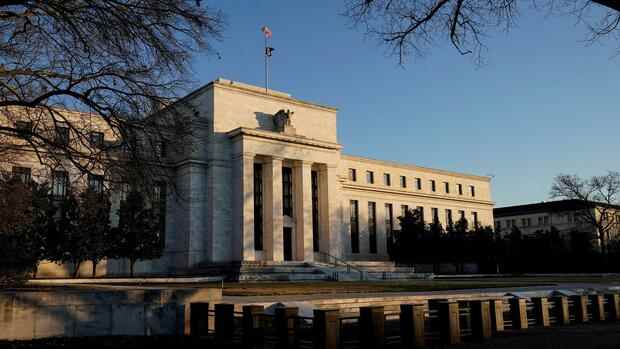Frankfurt Monetary policy is a topic for experts – and that applies all the more to the theoretical basis on which the central bankers justify their monetary policy. Because the monetary watchdogs have an immense influence on prices, unemployment and financial markets, a wrong theory can, in turn, cause a lot of mischief.
Against this background, a new study by economists Phurichai Rungcharoenkitkul and Fabian Winkler from the US Federal Reserve (Fed) in Washington is highly relevant. She questions a key argument for very low interest rates. Conversely, it could also have an impact on the pace of interest rate increases. In short: in the past central banks may have pushed rates down too far, now the opposite could happen – although the study itself does not draw the second conclusion explicitly.
The title of the article is “The Natural Rate of Interest Through a Hall of Mirrors”. The thesis is that the central banks base their monetary policy on an interest rate level that they essentially influence themselves without being aware of it. You look into a hall of mirrors and see yourself above all.
The decisive variable is the “natural interest rate”, or more precisely the “real equilibrium interest rate”, abbreviated as r* in technical jargon. It is the real interest rate, i.e. calculated after deducting inflation, at which the economy is operating at capacity but not overheating – i.e. there is full employment but no inflation.
Top jobs of the day
Find the best jobs now and
be notified by email.
According to the current theory, this interest rate depends on structural factors. Monetary policy generally has no direct influence. If a central bank wants to support the economy, it has to reach a level below r* by adjusting its key interest rate. If it wants to slow down the economy and thus also inflation, it has to set its interest rate level higher than r*.
Most monetary politicians say that r* has been falling ever since the great financial crisis at the latest – which is why the central banks have had to keep lowering their interest rates to the zero interest rate line or even lower. The situation is complicated by the fact that r* cannot be measured directly, but can only be derived indirectly.
The interest rate r* becomes the interest rate r**
The new study is based on a New Keynesian model, the theoretically conventional model, and incomplete information. The authors add an important point to the model: the expectations of the private sector, i.e. companies and consumers.
The expectations of the private sector regarding the long-term development of the equilibrium interest rate are crucial for the conclusions of the model. The authors refer to this rate as r**. The current equilibrium interest rate recedes into the background. In short: It depends on r**, not on r* anymore.
The crux of the matter is that the expectations of companies and consumers are largely influenced by the central bank itself. If it lowers or increases its interest rates, it gives the impression that it is assuming a correspondingly changed equilibrium interest rate. According to the model, the central bank then observes the changes in the behavior of the private sector and derives conclusions from this for its own assessment of the equilibrium interest rate: This creates multiple feedback loops and a self-reinforcing effect of adjusted interest rates.
The two Fed economists have fed a common model with corresponding assumptions and come to the conclusion that the persistently low interest rates, especially over the past ten years, can be explained very well. Due to the feedback effects described, the monetary watchdogs have themselves contributed to the fact that the equilibrium interest rate has recently fallen. The lower level since the financial crisis is therefore not solely due to exogenous factors, but partly to the central bank itself.
Does that mean the central bankers got it all wrong? No, not directly. But perhaps that they underestimate some of the feedback effects of their monetary policy.
More radical attacks in the past
There have been more radical attacks on the central bankers’ common thinking before. In 2016, for example, economist Stephen Williamson put forward a theory on the St. Louis Fed’s website that asserted: high interest rates make high inflation, low interest rates make low inflation—the opposite of conventional wisdom. The theory refers to the US economist Irving Fisher, who lived from 1867 to 1947.
In short, the reasoning is that real interest rates are determined solely by structural developments in the economy. For example, if the nominal interest rate is 3 percent and inflation is 2 percent, the real interest rate is 1 percent. If the central bank then raises the nominal interest rate to four percent, inflation must rise to three percent for the real interest rate to level off at its old level of one percent. As Williamson suggests, it is possible that in the short run monetary policy works as central banks assume – high interest rates dampen inflation – while in the long run the “Fisher effect” dominates in exactly the opposite way.
Another example: Claudio Borio, head of the monetary policy department at the Bank for International Settlements (BIS), believes that inflation depends on external factors such as globalization and mechanization and that central banks can hardly influence it. In this way, the central banks would only influence the nominal – and ultimately also the real – interest rates, but not the prices.
The study that has now been published by the Fed economists is particularly interesting because it does not radically turn all previous concepts on their head, but still comes to an unusual conclusion. In any case, one thing is clear: Monetary politicians not only have to face the current high practical challenges. They always have to check their theories as well – because they have enormous practical implications.
More: Investors hope for a soft landing
